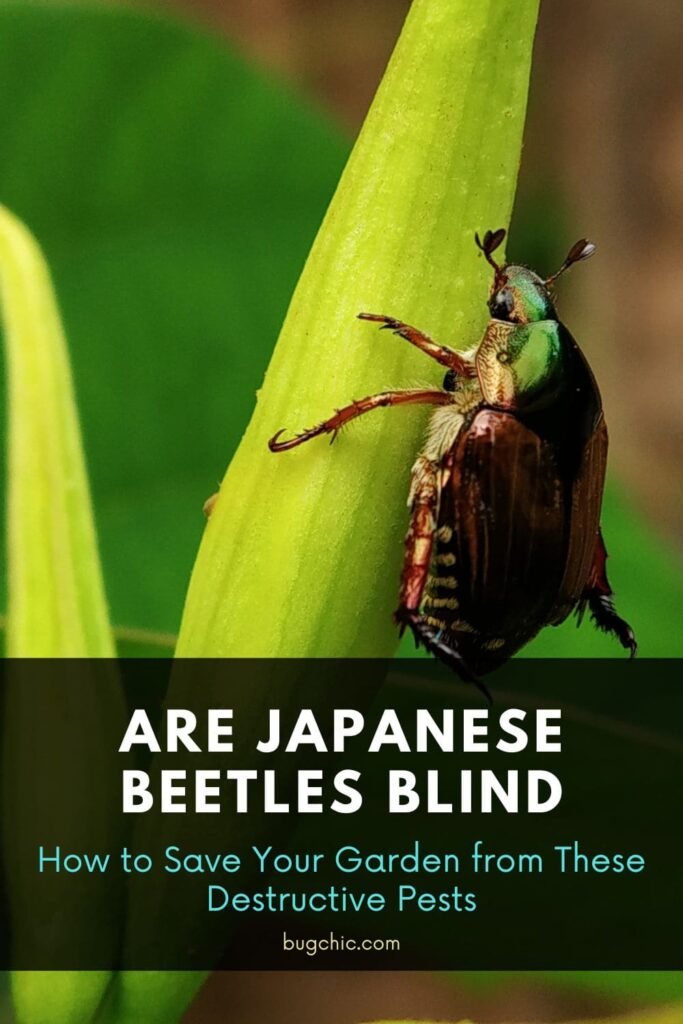

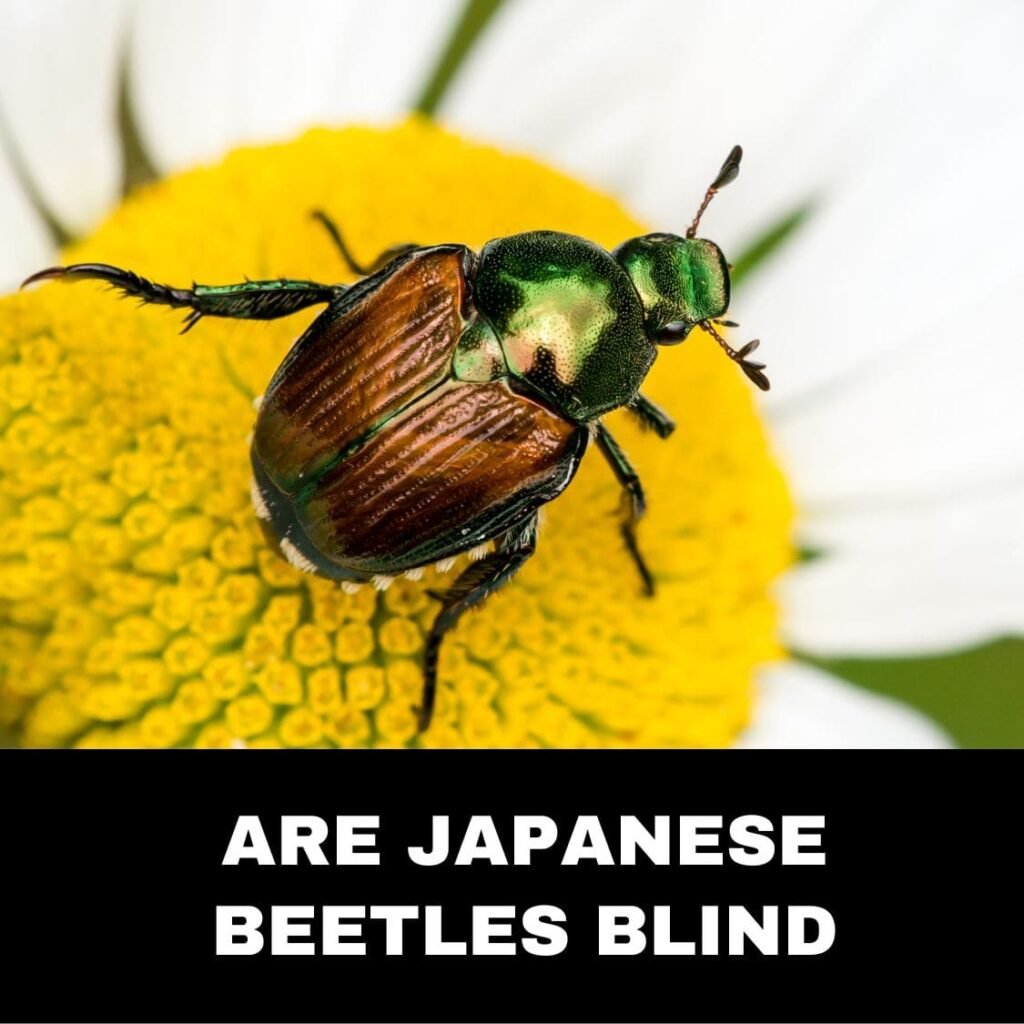
As a gardener, nothing is more frustrating than walking outside and finding your lovingly tended plants riddled with holes, leaves stripped down to the veins, and flowers reduced to petals scattered on the ground. And if you notice the culprits—shiny green and copper insects swarming en masse—then you’re dealing with one of the most notorious pests: Japanese beetles.
These invasive insects can decimate gardens, ornamental plants, agricultural crops, and fruit trees if left unchecked. But how exactly do these beetles go about finding and destroying so many plants? Are they using excellent eyesight to spot vulnerable new growth from yards away? Or are the beetles randomly bumping into vegetation as they meander around your property?
In other words—the question we all want answered : Are Japanese beetles blind?
Knowing whether these pests rely on vision or other senses when targeting plants can help you better protect your landscaping. In this post, we’ll cover everything you need to know about the eyes and eyesight of Japanese beetles, including:
Let’s dive in and find out if Japanese beetles are truly blind—and how much damage they can inflict on your yard even with limited vision!
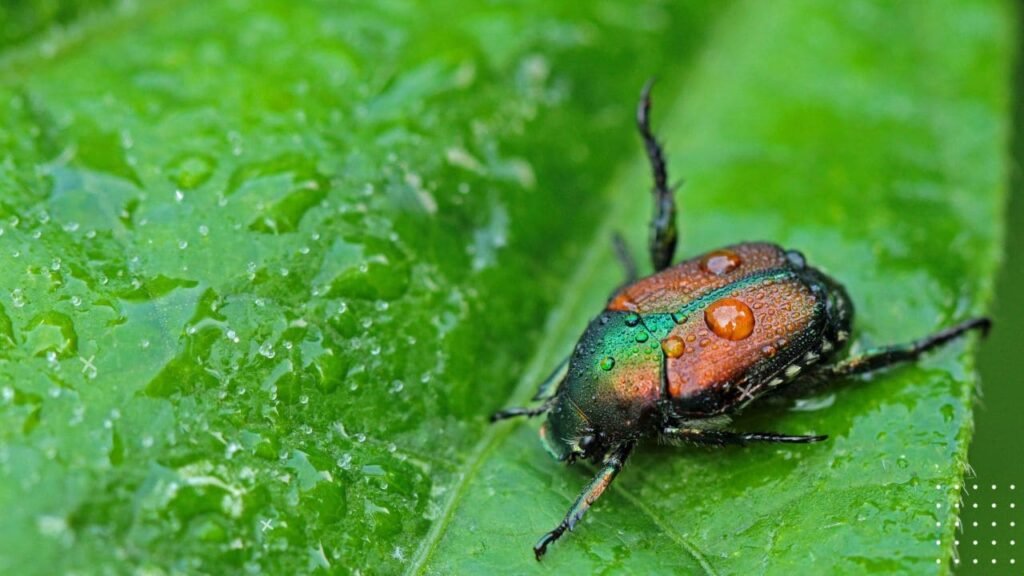
Japanese beetles (Popillia japonica) are part of the Scarabaeidae family of beetles, commonly known as scarabs. Like other beetles, Japanese beetles have a pair of compound eyes consisting of thousands of individual visual receptors called ommatidia.
So while their eyes may look different than human eyes, Japanese beetles definitely have visual organs—they are not blind. But their vision works differently than what we’re used to.
Each compound eye is made up of hundreds of six-sided units called ommatidia arranged hexagonally on the surface of the eye. Each ommatidium acts as an independent visual receptor, collecting light through a corneal lens.
Inside each ommatidium are light-sensitive cells called retinula that detect light and send signals to the optic lobe of the beetle’s brain, where the images are processed.
The many ommatidia give the beetles an incredible wide field of vision. Each ommatidium covers a small area, but together they create a mosaic image of the beetle’s surroundings.
When light hits the corneal lens of an ommatidium, it goes through a crystalline cone that focuses the light. The focused light then strikes the retinula cells at the bottom of the ommatidium.
The retinula cells contain rhodopsin, a photosensitive pigment. When rhodopsin absorbs the light, it triggers a signal to the optic lobe of the beetle’s brain through a nerve fiber.
The Japanese beetle’s brain combines the signals from all of the thousands of ommatidia in the compound eyes to generate a full image. This is very different from human eyes, where the retinas receive a single focused image.
So Japanese beetles do have eyes, and complex ones at that. Next let’s examine if they can actually see well with those eyes.
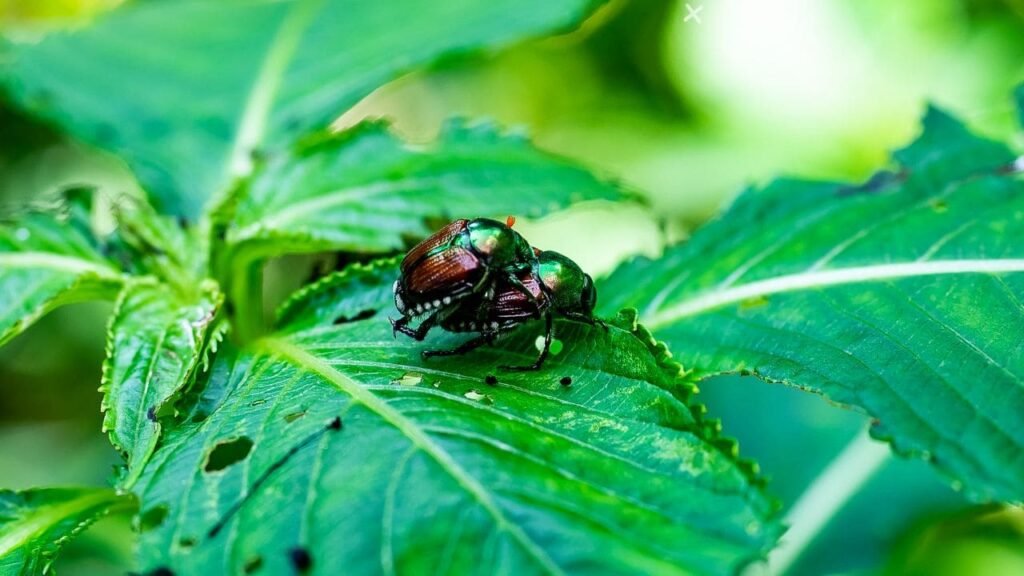
Given their small size and strange-looking eyes, you might assume Japanese beetles are blind, or at least have very poor vision. But scientific research shows that these pests do have functioning eyesight capable of detecting forms, movements, and light levels.
In 1965, researchers H. David and B.C. Broadbent conducted experiments analyzing how Japanese beetles reacted to different colored discs. They found the beetles could distinguish between darker discs and lighter backgrounds.
Additional studies determined that Japanese beetles can perceive human motion from 10-15 feet away, suggesting functional eyesight. Their eyes are sensitive to ultraviolet light, which helps them spot leaves and flowers.
So while Japanese beetles may not see crisp, detailed images like humans, they are not blind and can detect light, movement, forms, shadows, and colors to some degree.
The compound structure of Japanese beetles’ eyes gives them an incredibly wide field of vision. Each eye covers almost 180 degrees. And since their eyes are located on the sides of their head, they can see 360 degrees around them.
This gives Japanese beetles the advantage of detecting predators and food sources in all directions.
Interestingly, Japanese beetles have different types of ommatidia in their upper (dorsal) and lower (ventral) eyes:
So their eyes are highly adapted for both sensing food sources and predators.
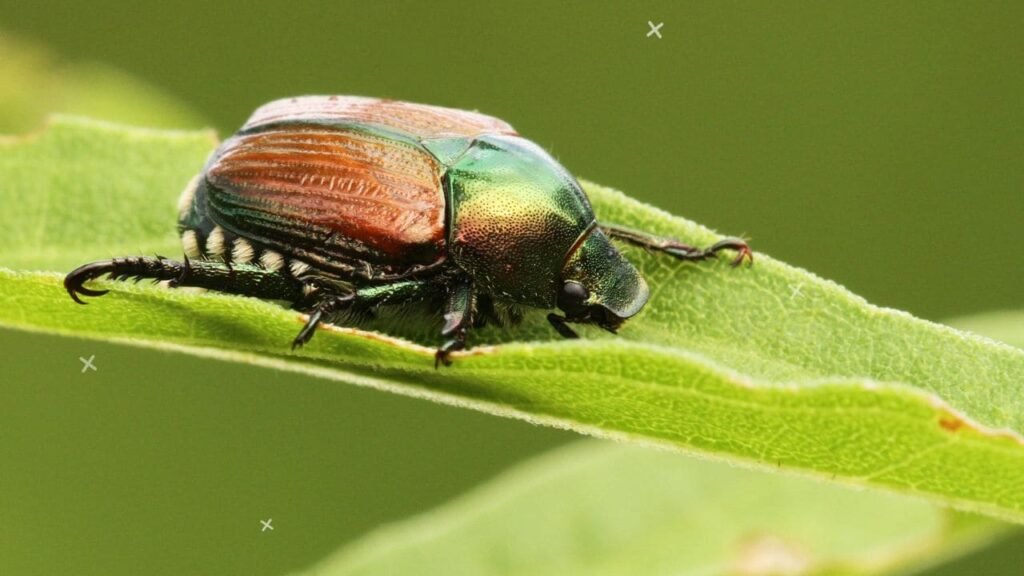
Given that they can perceive motion from 10-15 feet away, Japanese beetles likely have decent visual acuity for things within that range. But beyond that their vision becomes quite blurry.
Objects further than 20 feet away probably appear only as indistinct shapes and shadows to Japanese beetles. And anything past 30 feet or so is imperceptible.
For comparison, healthy young humans can generally perceive objects clearly up to 50 feet away.
So Japanese beetles do not have great long-distance vision. But their compound eyes and 360° visual field are well suited for detecting nearby food, mates, predators, and obstacles as they fly and crawl through vegetation.
Now that we know Japanese beetles aren’t blind, but also can’t see with perfect clarity from afar, let’s talk about how their vision factors into what plants they target.
Here are some of the top trees, shrubs, fruits, vegetables, herbs, and flowers Japanese beetles like to feed on:
Japanese beetles seem attracted to plants with bright green foliage, and prefer smooth, tender leaves and petals to tougher, hairy ones. This indicates they likely use sight to zero in on suitable host plants nearby.
But Japanese beetles don’t exclusively rely on vision to find plant hosts. Their antennae can detect plant odors from afar, luring them closer. And they respond to pheromones from other beetles, causing mass congregations on plants.
So while eyesight does play a role in host finding, Japanese beetles also use chemical senses once in the general vicinity of suitable plants.
| Plant | Beetle Preference | Susceptible Parts |
|---|---|---|
| Linden Trees | High | Leaves, flowers |
| Grape vines | High | Leaves, fruit |
| Rose bushes | High | Flowers, buds, leaves |
| Raspberries | Moderate | Leaves, ripening fruit |
| Birch Trees | Moderate | Leaves |
| Basil | Low | Leaves |
| Onions | Low | Leaves |
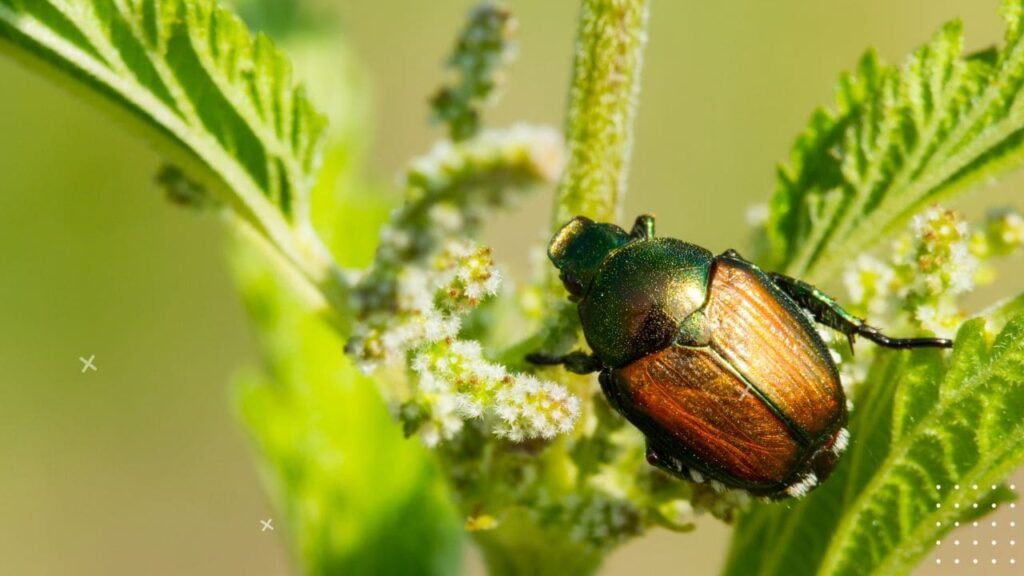
Adult Japanese beetles emerge from the ground in early summer and are active through late July into August, depending on your climate. They are most active on warm sunny days when temperatures exceed 75°F.
Their eyes likely help detect suitable plants through sunlight and shadows. And the warmth revs up their metabolisms, spurring them to mate and feed voraciously.
Peak activity is in mid-morning through early evening. Japanese beetles often take shelter in shady areas during hot mid-day sun.
At night they become inactive, clinging to plants and going dormant until morning. Their eyes have poor night vision, so they wait out the darkness.
Knowing when Japanese beetles are most lively gives you critical times to be vigilant about protecting plants.
Now that we’ve explored Japanese beetle eyesight and vision capabilities, let’s discuss smart ways to control these pests and prevent plant damage—without needing to eliminate every single beetle you see.
Here are some effective organic methods that work with or without good beetle eyesight:
Pluck any Japanese beetles you spot from your plants and drop them into soapy water to finish them off. This is most practical for small gardens.
Traps containing floral and sex pheromones attract beetles looking for food and mates. Place them along borders—not amidst plants—to draw beetles away.
Use these organic insecticides to safely kill beetles on contact and deter feeding. Reapply after rain.
Ladybugs, praying mantises, ground beetles, and birds all consume adult Japanese beetles. Avoid pesticides that could harm them.
Robust plants in nutrient-rich soil can better withstand some beetle damage. Improve soil health with compost and mulch.
Choose plants like begonias, tomato, broccoli, and onions that Japanese beetles tend to avoid. Diversify your landscape.
The key is vigilance, persistence, and not relying on any one tactic alone. Employ multiple organic methods to protect your greenery from Japanese beetle damage.
| Method | How it Works | When to Use | Limitations |
|---|---|---|---|
| Hand picking | Physically remove beetles from plants | Any time beetles are spotted | Time consuming for large infestations |
| Pheromone traps | Attracts beetles away from plants | Early summer before damage starts | Must be cleaned and maintained |
| Neem oil | Repels and kills beetles through contact | At first signs of damage | Must be reapplied frequently |
| Insecticidal soap | Kills beetles directly on contact | Moderate infestations | Doesn’t deter future beetles |
| Row covers | Forms physical barrier preventing access to plants | Before beetles emerge in early summer | Not practical for large trees |
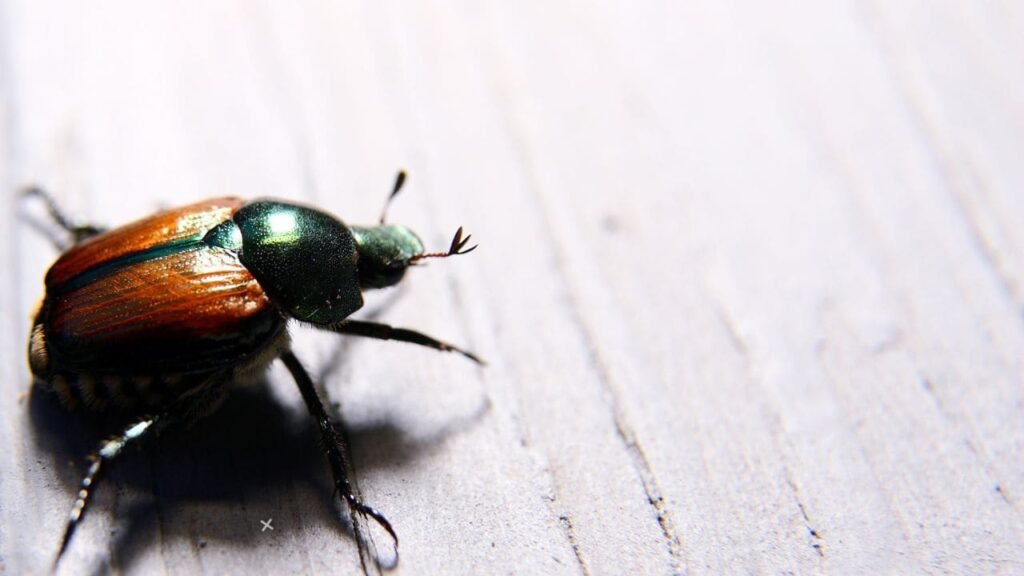
While natural control methods are ideal, some gardeners still prefer using traditional chemical pesticides on severe Japanese beetle infestations:
Insecticide sprays containing carbaryl, bifenthrin, or permethrin kill adults on contact. But they must be applied frequently, don’t last long, and can harm bees. Exercise caution.
Systemic insecticides like imidacloprid are taken up by plants’ vascular systems, making leaves and flowers toxic to beetles. But the chemicals persist for months, negatively impacting ecosystems. Only use as a last resort.
No pesticide will completely eliminate Japanese beetles. And over-reliance on chemicals often backfires, causing resistance in pests and harm to other wildlife. Evaluate if they are worth the ecological trade-offs.
If you have Japanese beetle favorites like roses or grape vines, here are some targeted tips to protect them:
For roses, spray neem oil or insecticidal soap weekly. Also apply kaolin clay spray, which deter beetles but is harmless when dry. Hand pick daily.
Cover grape vine leaves with lightweight fabric row covers. Apply sticky traps on poles near vines. Spray leaves with neem oil.
On birch trees, wrap double-sided tape sticky-side out around branches to trap beetles. Spray leaves with neem oil or insecticidal soap twice per week.
The takeaway is diligent monitoring, mechanical removal, and repeated applications of organic deterrents. Follow these tips specific to the plants Japanese beetles are attacking most on your property.
While controlling adult beetles is important for saving this year’s plants, there are also steps you can take to reduce populations next year:
Disrupting the Japanese beetles’ lifecycle is key for long-term sustainable management. Consistent prevention will minimize pest pressure on plants year after year.
While undoubtedly a nuisance, some posit Japanese beetles aren’t entirely detrimental. Research shows their larvae aerate soil and cycle nutrients by digesting turfgrass roots and thatch. And adult beetles provide a food source for birds, spiders, and other predators.
But any ecological benefits are outweighed by the extensive damage Japanese beetles inflict. Their lack of natural predators in North America allowed populations to explode. So don’t hesitate to implement controls to protect your plants!
To wrap up, Japanese beetles do have eyes—but they are not blind. Their compound eyes allow decent visibility of nearby objects and motion, but likely can’t see intricate details or long distances.
While eyesight aids their leaf-chewing ways, Japanese beetles also rely heavily on chemical senses from antennae to locate plants. A mix of visual and olfactory cues guides them to backyards and gardens brimming with flowers, produce, and foliage.
Luckily, knowledge of Japanese beetles’ imperfect vision empowers us gardeners to outsmart these pests. By using traps, physical barriers, natural repellents, and disrupting their lifecycle, we can keep plants flourishing despite Japanese beetles’ relentless efforts to indulge themselves on our greenery.
With persistence and savvy organic pest management skills, you can stay one step ahead of Japanese beetles and their leaf-munching appetites. So don’t let the notion of beetles swarming your yard dissuade you. With the right techniques, your garden can continue thriving unperturbed.
Here’s to successfully growing lush, gorgeous plants all season long, no matter how many Japanese beetles come knocking! Just remember—those beetles may be hungry, but their eyesight is far from perfect. You’ve got this!
How do I know if I have Japanese beetles in my yard?
Look for shiny green and copper insects around 1⁄2 inch long on your plants, usually in small groups. Check the undersides of leaves for characteristic skeletonization or holes between leaf veins. Also look for Japanese beetle grubs in your lawn or garden soil – they are white curl grubs with brown heads and six legs.
When during the day are Japanese beetles most active?
Japanese beetles are most active on warm, sunny days when temperatures exceed 75°F. Peak activity is from late morning to early evening, around 10am to 6pm. They often rest in shady areas during the hot mid-day hours. At night, Japanese beetles become inactive and dormant.
How far can Japanese beetles fly?
Japanese beetles can fly short distances up to 1-2 miles in search of food and mates. However, most beetles tend to stay within a few hundred feet of where they emerge as adults. Maintaining healthy, beetle-resistant plants within a 1⁄4 mile radius helps reduce colonization.
How long do Japanese beetles live?
The full lifecycle lasts one year. Adults emerge in early summer and live for 30-45 days feeding and mating. The females then lay eggs in soil, which hatch into grubs. The grubs grow through fall, overwinter underground, and pupate into adults the next summer. Individual adult beetles live about 1 month.
What natural predators eat Japanese beetles?
Birds like grackles, starlings, robins, and crows will feed on adult Japanese beetles. Beneficial insects like ground beetles, ants, and parasitoid wasps help control grubs in the soil. Spiders, praying mantises, and other generalist predators will also prey on Japanese beetles. Avoid pesticides that could kill these helpful predators!
